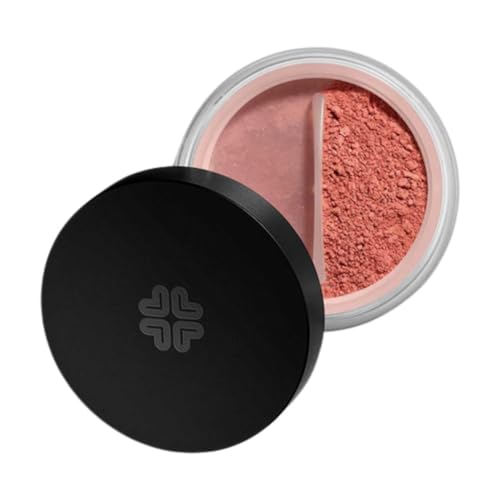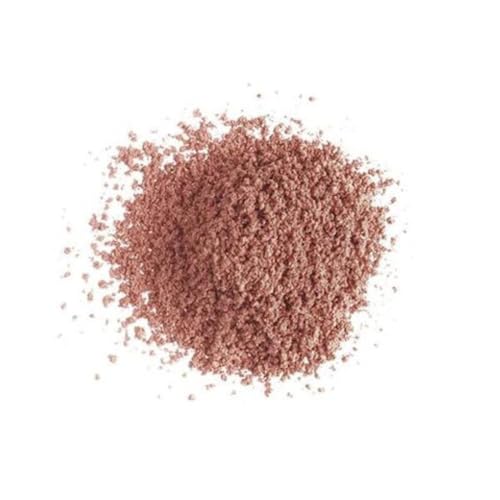

Lily Lolo Mineral Blush - Natural Glow, Vegan & Cruelty-Free - Sunset Shade, 3g


Ultramarines
High RiskUltramarine (CI 77007) is a mineral-based colorant primarily used in cosmetics and personal care products. It is known for providing vibrant blue hues and is derived from natural sources, making it popular in a variety of formulations.
Sustai Insights
Ultramarine offers functional benefits as a colorant enhancing product aesthetics. Although it is deemed low risk for cancer, allergies, and reproductive toxicity, it has high use restrictions due to regulatory concerns. Potential environmental risks include being a pollutant, while its overall risk level is assessed as high. Safe usage practices should be followed, and alternatives like plant-based colorants may be considered for more sustainable options.
Titanium Dioxide
Medium RiskTitanium dioxide is an inorganic compound used primarily as a pigment due to its brightness and high refractive index. It is commonly found in products such as paints, coatings, plastics, and cosmetics, providing color and opacity.
Sustai Insights
Titanium dioxide serves effectively as a UV filter and colorant, enhancing product stability and performance. However, it has been classified as a moderate concern for potential carcinogenicity and carries low risks for allergies and reproductive toxicity. Environmental risks include its pollutant potential, though it is not known to bioaccumulate. Regulatory bodies have issued specific restrictions regarding its use, leading to an overall medium risk assessment. Safe usage practices should be observed, with consideration for alternatives such as zinc oxide for a more sustainable option.
Sand
Low RiskSand is loose, granular particles of worn or disintegrated rock, primarily composed of silica. It is commonly used as an abrasive, filler, or in construction and landscaping for its structural properties.
Sustai Insights
Sand offers functional benefits such as providing bulk and texture in various products, and it is generally considered to have low health risks, with minimal concerns regarding carcinogenicity, allergies, or reproductive toxicity. Environmentally, sand does not contribute significantly to pollution and is not bioaccumulative. Regulatory bodies do not impose restrictions on sand usage, maintaining its low-risk status. Safe usage practices should be followed to avoid inhalation of fine particles. Overall, sand is a low-risk ingredient with no notable negative impacts.
Magnetite (Fe3 O4)
Low RiskMagnetite (Fe3O4) is a naturally occurring iron oxide commonly found in the environment. It is often utilized in various applications, including its role as a pigment, in magnetic materials, and in environmental remediation processes due to its magnetic properties.
Sustai Insights
Magnetite has functional benefits such as serving as an effective magnetic material and playing a role in environmental cleanup. Health risks are low, with minimal concerns regarding carcinogenicity, allergenic potential, or reproductive toxicity. Environmentally, it poses low pollution risk and does not bioaccumulate. Regulatory bodies impose no significant restrictions, indicating a low overall risk level. Safe usage practices should be followed, and alternatives may include other magnetic materials, but magnetite remains a viable option.
Ultramarines
High RiskUltramarine (CI 77007) is a mineral-based colorant primarily used in cosmetics and personal care products. It is known for providing vibrant blue hues and is derived from natural sources, making it popular in a variety of formulations.
Sustai Insights
Ultramarine offers functional benefits as a colorant enhancing product aesthetics. Although it is deemed low risk for cancer, allergies, and reproductive toxicity, it has high use restrictions due to regulatory concerns. Potential environmental risks include being a pollutant, while its overall risk level is assessed as high. Safe usage practices should be followed, and alternatives like plant-based colorants may be considered for more sustainable options.
Titanium Dioxide
Medium RiskTitanium dioxide is an inorganic compound used primarily as a pigment due to its brightness and high refractive index. It is commonly found in products such as paints, coatings, plastics, and cosmetics, providing color and opacity.
Sustai Insights
Titanium dioxide serves effectively as a UV filter and colorant, enhancing product stability and performance. However, it has been classified as a moderate concern for potential carcinogenicity and carries low risks for allergies and reproductive toxicity. Environmental risks include its pollutant potential, though it is not known to bioaccumulate. Regulatory bodies have issued specific restrictions regarding its use, leading to an overall medium risk assessment. Safe usage practices should be observed, with consideration for alternatives such as zinc oxide for a more sustainable option.
Sand
Low RiskSand is loose, granular particles of worn or disintegrated rock, primarily composed of silica. It is commonly used as an abrasive, filler, or in construction and landscaping for its structural properties.
Sustai Insights
Sand offers functional benefits such as providing bulk and texture in various products, and it is generally considered to have low health risks, with minimal concerns regarding carcinogenicity, allergies, or reproductive toxicity. Environmentally, sand does not contribute significantly to pollution and is not bioaccumulative. Regulatory bodies do not impose restrictions on sand usage, maintaining its low-risk status. Safe usage practices should be followed to avoid inhalation of fine particles. Overall, sand is a low-risk ingredient with no notable negative impacts.
Magnetite (Fe3 O4)
Low RiskMagnetite (Fe3O4) is a naturally occurring iron oxide commonly found in the environment. It is often utilized in various applications, including its role as a pigment, in magnetic materials, and in environmental remediation processes due to its magnetic properties.
Sustai Insights
Magnetite has functional benefits such as serving as an effective magnetic material and playing a role in environmental cleanup. Health risks are low, with minimal concerns regarding carcinogenicity, allergenic potential, or reproductive toxicity. Environmentally, it poses low pollution risk and does not bioaccumulate. Regulatory bodies impose no significant restrictions, indicating a low overall risk level. Safe usage practices should be followed, and alternatives may include other magnetic materials, but magnetite remains a viable option.
Discover a radiant glow with Lily Lolo Mineral Blush in Sunset. This eco-friendly blush enhances your natural beauty while being kind to your skin and the planet. Perfect for the environmentally conscious consumer, it provides a soft, buildable color that lasts all day without compromising on health or sustainability.
- Natural Ingredients: Formulated with gluten-free mica and silica, this blush is gentle on the skin and suitable for sensitive complexions.
- Easy Application: Achieve a flawless finish with simple steps: prepare your skin, choose the right brush, and blend for a seamless look.
- Customizable Intensity: Start light and build to your desired depth, allowing for versatile looks from subtle to bold.
- Cruelty-Free: Proudly free from animal testing, this blush aligns with ethical beauty practices.
- Eco-Friendly Packaging: Packaged sustainably, it reflects a commitment to reducing environmental impact, appealing to conscious consumers.
With Lily Lolo Mineral Blush, enjoy a beautiful, healthy glow while making a responsible choice for your beauty routine.
Subscribe & Save with Sustai
- Best Price Guarantee: Always enjoy the lowest prices on sustainable home essentials.
- No Surprises: We’ll notify you before shipping. No hidden fees, ever.
- You’re in Charge: Change, pause, or cancel your subscription anytime with ease.
- Eco-Friendly Deliveries: Our grouped shipments mean less packaging and lower emissions.
Join us on a sustainable journey. Special offers for a limited time! Prices and promotions may change.
Recommended Products
Discover a radiant glow with Lily Lolo Mineral Blush in Sunset. This eco-friendly blush enhances your natural beauty while being kind to your skin and the planet. Perfect for the environmentally conscious consumer, it provides a soft, buildable color that lasts all day without compromising on health or sustainability.
- Natural Ingredients: Formulated with gluten-free mica and silica, this blush is gentle on the skin and suitable for sensitive complexions.
- Easy Application: Achieve a flawless finish with simple steps: prepare your skin, choose the right brush, and blend for a seamless look.
- Customizable Intensity: Start light and build to your desired depth, allowing for versatile looks from subtle to bold.
- Cruelty-Free: Proudly free from animal testing, this blush aligns with ethical beauty practices.
- Eco-Friendly Packaging: Packaged sustainably, it reflects a commitment to reducing environmental impact, appealing to conscious consumers.
With Lily Lolo Mineral Blush, enjoy a beautiful, healthy glow while making a responsible choice for your beauty routine.

You can have at most 2 Sustainable Steals products in your cart
Customer Reviews
Customers’ View
Customers appreciate the natural formulation of the Mineral Blush in Sunset Shade, noting its effective and smooth application. Many users highlight the product's versatility, enjoying how it can be built up for varying intensities to suit different occasions. The eco-friendly ingredients resonate particularly well with health-conscious consumers, as they value the non-toxic nature of the product, which is safe for sensitive skin. Additionally, the compact size is praised for its convenience, making it a great option for travel. Overall, customers find this blush to be a reliable choice that aligns with their sustainable and health-focused lifestyles.
AI-generated from the text of customer reviewsThis product has no reviews yet.




